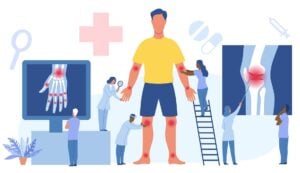
July 24 – 30 (2017) is National Pain Week – an initiative led by Chronic Pain Australia. Their mission is to reduce the barriers, suffering and isolation faced by people living with pain by encouraging discussion amongst patients, communities, services and the media, addressing the stigmatisation of chronic pain, and providing access to information and resources that will help patients manage their pain as well as the social and economic burdens that they face.
Around 1 in 5 Australians suffer from chronic pain.

Acute pain is often “nociceptive” pain – a normal response to tissue damage. It is generally treatable and easily resolved. Pain that is caused by damage to or a disease of the nervous system is termed “neuropathic” pain. Neuropathic pain is often harder to diagnose and treat. Pain is considered chronic if it persists for more than 3 months.
Chronic pain is complex and a highly personal experience. Not only does it depend on the cause, it also depends heavily on individual factors, such as genetics, lifestyle, past experiences, present circumstances, way of thinking and emotions/mood. Research and statistics have identified numerous lifestyle factors that increase the risk of developing chronic pain and/or its severity. Smoking, obesity and inactivity are prime examples; conversely, all of which are often a consequence of chronic pain.
Whether originally nociceptive or neuropathic, chronic pain is generally considered to involve changes in the central nervous system – how the spinal cord and brain respond to pain. Patients may become more sensitive to pain (“central sensitisation”), and in some cases, to non-painful stimuli too (i.e. touch and pressure).
Many consider chronic pain to be an “invisible illness” because there are often no obvious, visible signs (i.e. a broken limb). Together with the fact that it often has a significant mental element, people with chronic pain are largely misunderstood. Patients commonly feel misjudged, that they are not being taken seriously, and sometimes even made to feel that they are “making things up”.
Furthermore, various other stigmatised issues commonly accompany chronic pain, such as disability, fatigue and mental health conditions. Socioeconomic status is also often affected. People with chronic pain are especially prone to developing anxiety and/or depression. Struggling to or no longer being able to work and perform daily activities of living are extremely burdening to patients (and their families).
All of this often leads to feelings of isolation and social withdrawal, which can further feed into mental health issues. Chronic pain is a devastating cycle. Patients deserve far better understanding and support.
Usually, the first point of medical contact for someone suffering from pain will be the GP. Analgesic medications may be prescribed, although it is recommended that a referral to a specialist pain physician, preferably at a multidisciplinary clinic, comes next in order to most effectively manage complex chronic pain.
A pain physician will perform a comprehensive pain assessment and examination during consultation, enabling a more accurate diagnosis and establishment of an appropriate, wholesome, individually-tailored treatment plan. A pain physician may prescribe various classes and combinations of medications (i.e. analgesics, antidepressants, muscle relaxants), perform day surgery procedures such as injections, nerve blocks and neurotomies, as well as more advanced surgical procedures such as implantation of spinal cord or peripheral nerve stimulators.
A combination of treatments / therapies and a team of health care professionals who specialist in pain is often necessary. Along with the pain physician, these include pain specialist nurses, psychologists, psychiatrists, physiotherapists, exercise physiologists, occupational therapists, etc. A multidisciplinary pain clinic will house many of these professionals and may offer pain management programs, rehabilitation services and even research services (clinical trials).
The most effective management is achieved when the patient becomes part of a team, working together with various health professionals and actively participating in the management of their pain.
View our currently recruiting studies:
Register your interest for future studies:
© Genesis Research Services, 2023